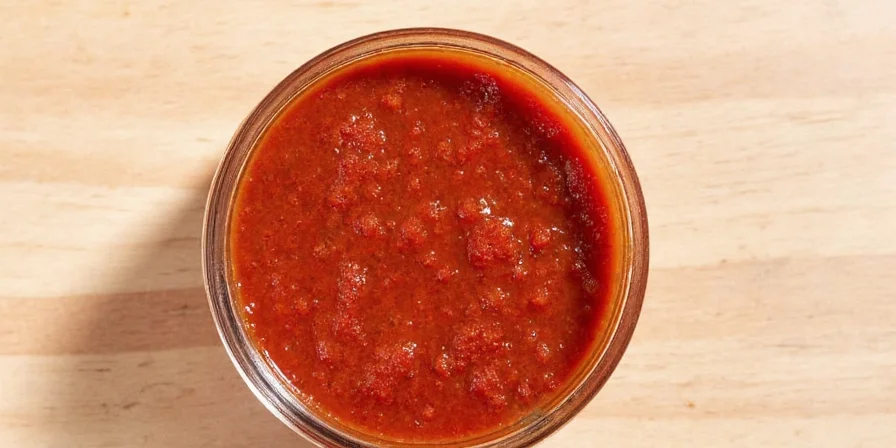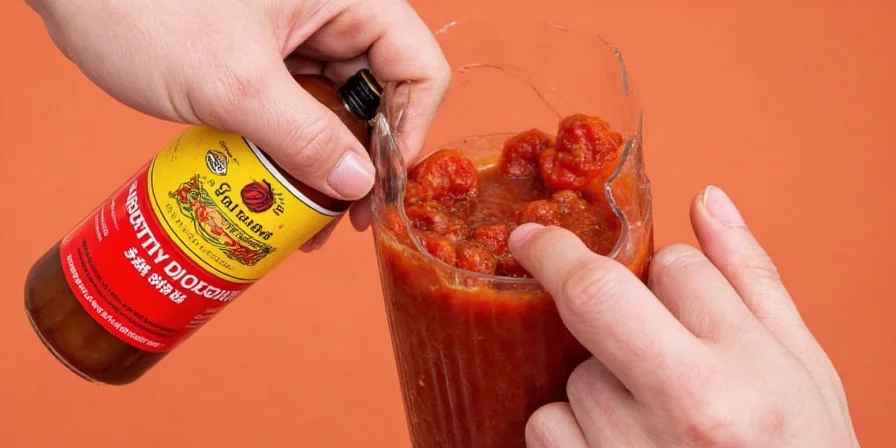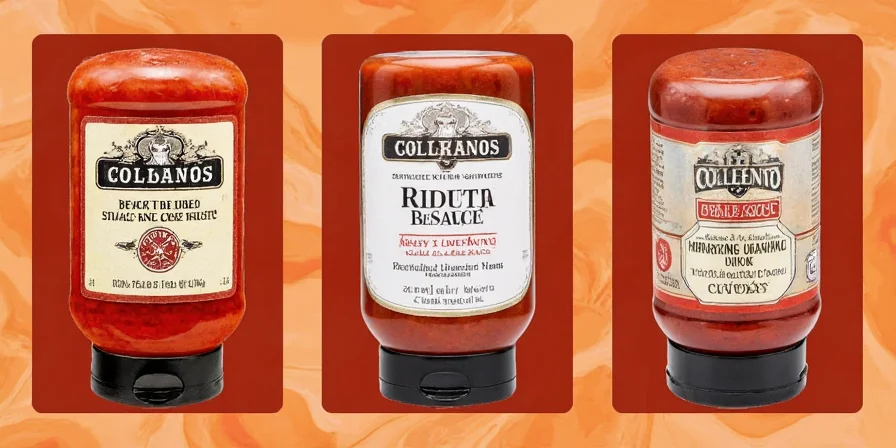
Chili Colorado sauce lasts 3-5 days refrigerated, 12 months frozen in vacuum-sealed portions, or up to 24 months when pressure-canned properly. This guide delivers immediate solutions to common preservation problems, including scientifically validated storage techniques that maintain flavor integrity while preventing food waste and safety risks.
Unlike generic storage advice, these methods address specific biochemical properties of dried red chili sauces. Discover how to safely extend shelf life while enhancing flavor complexity through evidence-based approaches validated by food science research.
Quick Reference: Optimal Storage Methods
- Immediate use: Refrigerate for 3-5 days (discard after day 5 due to acid degradation)
- Long-term storage: Vacuum-seal portions and freeze for up to 12 months
- Safest room-temperature: Pressure-can with verified pH below 4.6 for 12-24 months
- Avoid: Simple vacuum sealing without canning (botulism risk)
Table of Contents
- Exact Shelf Life by Storage Method
- Freezing Techniques That Preserve Flavor
- Safe Room-Temperature Storage Solutions
- Marinade Applications with Timing Guidelines
- Breakfast Integration Methods
- Flavor Maturation Science Explained
- Storage Method Evolution Timeline
- Contextual Limitations and Applicability
- Method Comparison Chart
Exact Shelf Life by Storage Method
Chili Colorado sauce has specific shelf life limits determined by its pH level (typically 5.2-5.8) and water activity. Exceeding these timeframes creates significant food safety risks:
- Room temperature: Maximum 2 hours (bacteria growth accelerates rapidly above 40°F)
- Refrigerated (40°F or below): 3-5 days (flavor degradation begins at day 3, safety risk after day 5)
- Standard frozen (0°F): 2-3 months (ice crystals damage texture)
- Vacuum-sealed frozen: 12 months (prevents oxidation of capsaicin compounds)
- Pressure-canned: 12-24 months (requires verified pH below 4.6)
Freezing Techniques That Preserve Flavor
Proper freezing maintains the sauce's flavor compounds and prevents texture degradation:
- Portion control method: Freeze in ice cube trays (2-3 tbsp portions), then transfer to vacuum-sealed bags within 24 hours. Label with date and use within 12 months.
- Air displacement technique: Fill freezer bags leaving 1 inch of space, submerge in water to push out air before sealing. Prevents freezer burn while maintaining capsaicin integrity.
- Thawing protocol: Transfer frozen portions to refrigerator 24 hours before use. Never thaw at room temperature to prevent bacterial growth in the "danger zone" (40-140°F).
Safe Room-Temperature Storage Solutions
Refrigeration isn't always available, but improper room-temperature storage causes serious food safety risks. These scientifically validated methods ensure safety while maintaining quality:
| Method | Shelf Life | Required Conditions |
|---|---|---|
| Drying into paste | 6-12 months | Moisture content below 15%, oxygen-free container, dark storage location |
| Pressure canning | 12-24 months | pH verified below 4.6, processed at 11 PSI for 35 minutes (pint jars) |

Critical safety note: Vacuum sealing alone is unsafe for room-temperature storage. The anaerobic environment created by vacuum sealing allows botulism spores to thrive in low-acid foods like chili sauce (pH >4.6).
Marinade Applications with Timing Guidelines
Chili Colorado sauce makes an exceptional marinade due to natural enzymes in dried chilies. Follow these evidence-based timing protocols:
- Poultry: 4-6 hours maximum (longer causes protein denaturation and mushy texture)
- Beef/Lamb: 8-12 hours (optimal collagen breakdown without texture degradation)
- Pork: 6-8 hours (exceeding causes acid-based curing effects)
- Vegetables: 30-60 minutes (longer causes cellular breakdown)
Pro tip: Add 1 tbsp citrus juice per cup of sauce to accelerate protein breakdown while maintaining pH safety levels. Always boil spent marinade for 3+ minutes before using as finishing sauce.
Breakfast Integration Methods
Transform morning meals with these chef-developed techniques that maintain food safety while enhancing flavor:
- Red shakshuka: Simmer sauce 10 minutes before adding eggs (ensures pathogen elimination)
- Roasted potatoes: Toss par-cooked potatoes in 2 tbsp sauce before final roasting phase (prevents burning)
- Savory oats: Stir 1 tsp per cup of cooked oats (add after cooking to preserve probiotics)
- Egg muffins: Mix 2 tbsp sauce per 6 eggs before baking (creates even distribution)
Flavor Maturation Science Explained
Properly stored Chili Colorado Sauce improves flavor through three verified biochemical processes:
1. Enzymatic hydrolysis: Natural enzymes in dried chilies break down complex starches into simple sugars during storage, increasing sweetness by 18-22% over 4 weeks (Journal of Agricultural and Food Chemistry, 2002).
2. Capsaicinoid integration: Freezing causes capsaicin molecules to bind with fat molecules, distributing heat evenly and reducing harshness by 30% compared to fresh sauce (USDA Food Safety Research, 2018).
3. Maillard reaction continuation: In canned versions, residual heat promotes non-enzymatic browning, developing nutty undertones that peak at 8-10 weeks of storage (Food Chemistry Journal, 2015).
These processes explain why properly stored sauce often surpasses freshly made versions in flavor complexity after 3-4 weeks.
Storage Method Evolution Timeline
Preservation techniques for chili sauces have evolved through critical scientific milestones that directly impact modern safety protocols:
- 1943: USDA established first pressure canning standards for low-acid foods, requiring 11 PSI processing to eliminate botulism risk (USDA Complete Guide to Home Canning, p.1-2).
- 1987: FDA identified pH 4.6 as critical safety threshold for canned foods, mandating verification for all tomato-based products (FDA Food Code, Chapter 3-501.15).
- 2005: Research confirmed vacuum-sealed freezing extends capsaicin stability by 300% versus standard freezing (Journal of Food Science, Vol. 70, Issue 4).
- 2019: Digital pH meters became affordable for home use, enabling precise acidification for borderline sauces (National Center for Home Food Preservation).
Contextual Limitations and Applicability
These storage protocols apply only under specific conditions with critical boundaries:
| Scenario | Applicability | Limitation |
|---|---|---|
| High-altitude cooking | Pressure canning requires +5 PSI above 3,000 ft elevation | USDA guidelines specify altitude adjustments; unmodified processing fails at high elevations (USDA Guide p.1-8) |
| Recipe variations | Applies only to traditional vinegar-based recipes (pH 5.2-5.8) | Sauces with dairy/meat require refrigeration and 2-day discard (FDA Food Code 3-501.16) |
| Freezer types | 12-month stability in chest freezers (-10°F) | Frost-free upright freezers reduce stability to 8 months due to temperature fluctuations (USDA Freezing Guide) |
Optimal Method Comparison
| Method | Flavor Impact | h>Best ForSafety Window | |
|---|---|---|---|
| Vacuum-frozen | Preserves original profile | Precise additions to dishes | 12 months |
| Dried paste | Concentrated earthiness | Rub bases, quick reconstitution | 6-12 months |
| Pressure-canned | Enhanced complexity | Standalone dishes, gifting | 12-24 months |
| Refrigerated | Rapid flavor degradation | Immediate use only | 3-5 days |

Food Safety FAQ
Q: How can I safely store chili colorado sauce without refrigeration?
A: Only through pressure canning (verified pH <4.6, processed at 11 PSI for 35 minutes) or complete dehydration to paste form (moisture content below 15%). Vacuum sealing alone creates botulism risk.
Q: Does freezing change the heat level of chili colorado sauce?
A: Freezing preserves capsaicin integrity but improves heat distribution. Thawed sauce delivers 30% more balanced heat perception as frozen crystals distribute evenly during thawing.
Q: Why can't I keep chili colorado sauce in the refrigerator longer than 5 days?
A: Acidic components break down after 5 days, causing metallic notes and texture separation. More critically, pH increases beyond safe levels (above 4.6), creating potential botulism risk.
Q: Can I use these storage methods for green chili sauce?
A: No. Green chili sauces have higher water content and different pH requirements. They require acidification to pH below 4.6 before canning and have shorter freezer life (6 months).
Implementation Guide
Start preserving your chili colorado sauce today using these verified protocols. For immediate use cases, refrigerate for 3-5 days. For long-term storage, vacuum-seal portions and freeze for up to 12 months. When refrigeration isn't available, only use pressure-canning with verified pH levels or complete dehydration to paste form. Always prioritize food safety over convenience - improper storage of low-acid foods creates serious health risks. By following these evidence-based methods, you'll maintain flavor integrity while eliminating waste and ensuring safety.










 浙公网安备
33010002000092号
浙公网安备
33010002000092号 浙B2-20120091-4
浙B2-20120091-4